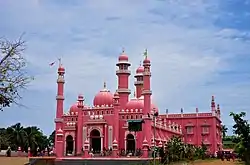Beemapally
Beemapally, a suburb of Thiruvananthapuram. Beemapally is famous for its mosque, Beemapally Dargah Shareef, which houses the tomb of Syedunnisa Beema Beevi, a woman believed to have divine powers, and her son Syedu Shuhada Maheen Abubacker. Every year there is a festival held to venerate Beema Beevi which attracts thousands of pilgrims from all faiths and castes. Beemapally Masjid is an impressive building with its imposing façade and soaring minarets. The tomb of Beema Beevi, the lady with miraculous powers who is believed to belong to the Prophet Mohammed’s family, is the main attraction at this mosque. People of all faiths come to offer prayers at Beemapally.
Beemapally | |
|---|---|
Suburb | |
 | |
| Coordinates: 8.495945°N 76.954381°E | |
| Country | |
| State | Kerala |
| District | Thiruvananthapuram |
| Area | |
| • Total | 1.19 km2 (0.46 sq mi) |
| Languages | |
| • Official | Malayalam, English |
| Time zone | UTC+5:30 (IST) |
| PIN | 695008 |
| Telephone code | 0471 |
| Vehicle registration | KL-01 |
| Architect | G. Gopalakrishnan[1] |
Annual Urus
Beemapally Mosque is famous for its annual urus which attracts scores of pilgrims from all walks of life. The festival, which marks the death anniversary of Syedunnisa Beema Beevi, starts on the first of Jama dul Akbar and continues for the next ten days.[2] The celebration begins with the hoisting of the customary flag of the mosque in front of the elders and other devotees. The devotees carry money in pots which are adorned with flowers and incense sticks. The pot’s opening is swathed in white cloth and a garland is fastened around the neck. The pots are daubed with sandal paste which is why the festival is called Chandanakudam (sandal pot).Beemapalli Mosque is a hub of activity during the festivities and many art forms like daharamuttu are performed in the mosque. Many religious discussions are held and Islamic devotional songs are performed outside the mosque. On the final day of Chandanakudam Mahotsavam, a flag from Beema Bibi’s grave is taken; there is a grand procession with caparisoned elephants and the music of the panchavadyam (five instruments).
References
- http://www.thehindubusinessline.com/life/2003/12/22/stories/2003122200040400.htm
- "Beemapally Urus Tomorrow". Archived from the original on 21 March 2019. Retrieved 21 March 2019.